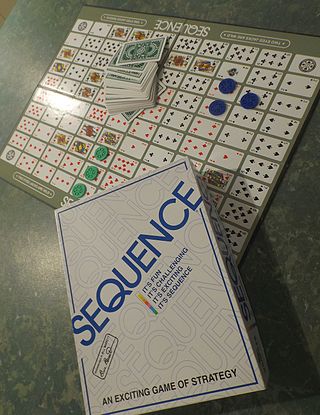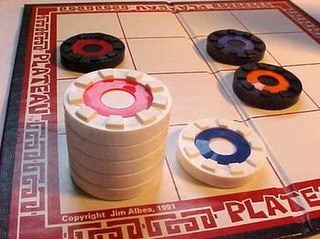Related Research Articles
Game theory is the study of mathematical models of strategic interactions among rational agents. It has applications in all fields of social science, as well as in logic, systems science and computer science. The concepts of game theory are used extensively in economics as well. The traditional methods of game theory addressed two-person zero-sum games, in which each participant's gains or losses are exactly balanced by the losses and gains of other participants. In the 21st century, the advanced game theories apply to a wider range of behavioral relations; it is now an umbrella term for the science of logical decision making in humans, animals, as well as computers.

The rules of Go have seen some variation over time and from place to place. This article discusses those sets of rules broadly similar to the ones currently in use in East Asia. Even among these, there is a degree of variation.

Lloyd Stowell Shapley was an American mathematician and Nobel Memorial Prize-winning economist. He contributed to the fields of mathematical economics and especially game theory. Shapley is generally considered one of the most important contributors to the development of game theory since the work of von Neumann and Morgenstern. With Alvin E. Roth, Shapley won the 2012 Nobel Memorial Prize in Economic Sciences "for the theory of stable allocations and the practice of market design."
In game theory, the centipede game, first introduced by Robert Rosenthal in 1981, is an extensive form game in which two players take turns choosing either to take a slightly larger share of an increasing pot, or to pass the pot to the other player. The payoffs are arranged so that if one passes the pot to one's opponent and the opponent takes the pot on the next round, one receives slightly less than if one had taken the pot on this round, but after an additional switch the potential payoff will be higher. Therefore, although at each round a player has an incentive to take the pot, it would be better for them to wait. Although the traditional centipede game had a limit of 100 rounds, any game with this structure but a different number of rounds is called a centipede game.

Sequence is an abstract strategy tabletop party game. Sequence was invented by Douglas Reuter and Hamish. They originally called the game Sequence Five. He spent years developing the concept, and, in June 1981, granted Jax Ltd. an exclusive license to manufacture, distribute and sell the board game Sequence and its subsequent variations. The game was first sold in a retail store in 1982. In 2017, Goliath Game Company bought Jax, and in early 2018 also bought all licensor rights and now owns 100% of the game Sequence. Doug Reuter is acknowledged as the inventor of Sequence on all newly produced copies of the game - both on the box and in the printed rules.
In game theory, the stag hunt, sometimes referred to as the assurance game, trust dilemma or common interest game, describes a conflict between safety and social cooperation. The stag hunt problem originated with philosopher Jean-Jacques Rousseau in his Discourse on Inequality. In the most common account of this dilemma, which is quite different from Rousseau's, two hunters must decide separately, and without the other knowing, whether to hunt a stag or a hare. However, both hunters know the only way to successfully hunt a stag is with the other's help. One hunter can catch a hare alone with less effort and less time, but it is worth far less than a stag and has much less meat. It would be much better for each hunter, acting individually, to give up total autonomy and minimal risk, which brings only the small reward of the hare. Instead, each hunter should separately choose the more ambitious and far more rewarding goal of getting the stag, thereby giving up some autonomy in exchange for the other hunter's cooperation and added might. This situation is often seen as a useful analogy for many kinds of social cooperation, such as international agreements on climate change.

Djambi is a board game and a chess variant for four players, invented by Jean Anesto in 1975. The rulebook in French describes the game, the pieces and the rules in a humorous and theatrical way, clearly stating that the game pieces are intended to represent all wrongdoings in politics.
In game theory, fictitious play is a learning rule first introduced by George W. Brown. In it, each player presumes that the opponents are playing stationary strategies. At each round, each player thus best responds to the empirical frequency of play of their opponent. Such a method is of course adequate if the opponent indeed uses a stationary strategy, while it is flawed if the opponent's strategy is non-stationary. The opponent's strategy may for example be conditioned on the fictitious player's last move.

Monopoly: The Card Game is loosely based on the board game Monopoly. The idea is to draw, trade and organize cards into "color-groups" along with bonus cards. Players take turns drawing and discarding cards until one completes a hand. The value of each player's hand is then counted and they receive the amount of Monopoly money they have earned. The first person to collect $10,000 wins.

Banqi or Half Chess, also known as Dark Chess (暗棋) or Blind Chess (盲棋), is a two-player Chinese board game played on a 4×8 grid, or half of the xiangqi board. Most games last between ten and twenty minutes, but advanced games can last for an hour or more. Banqi is a social game, usually played for fun rather than serious competition. A more formal version of Banqi may have evolved into the games Jungle and modern Luzhanqi.
Switch, also called Two Four Jacks or Irish Switch, or Last Card in New Zealand, is a shedding-type card game for two or more players that is popular in the United Kingdom, Ireland and as alternative incarnations in other regions. The sole aim of Switch is to discard all of the cards in one's hand; the first player to play her, his, or their final card, and ergo have no cards left, wins the game. Switch is very similar to the games UNO, Flaps and Mau Mau, both belonging to the larger Crazy Eights or Shedding family of card games.
In game theory, a subgame perfect equilibrium is a refinement of a Nash equilibrium used in dynamic games. A strategy profile is a subgame perfect equilibrium if it represents a Nash equilibrium of every subgame of the original game. Informally, this means that at any point in the game, the players' behavior from that point onward should represent a Nash equilibrium of the continuation game, no matter what happened before. Every finite extensive game with perfect recall has a subgame perfect equilibrium. Perfect recall is a term introduced by Harold W. Kuhn in 1953 and "equivalent to the assertion that each player is allowed by the rules of the game to remember everything he knew at previous moves and all of his choices at those moves".
Martin Shubik (1926-2018) was an American mathematical economist who specialized in game theory, defense analysis, and the theory of money and financial institutions. The latter was his main research interest and he coined the term "mathematical institutional economics" in 1959 to describe it and referred to it as his "white whale". He spent the majority of his career at Yale University, where he was heavily involved with the Cowles Foundation for Research in Economics, and launched the virtual Museum of Money and Financial Institutions.
The Shapley–Shubik power index was formulated by Lloyd Shapley and Martin Shubik in 1954 to measure the powers of players in a voting game. The index often reveals surprising power distribution that is not obvious on the surface.

Plateau is a two-player abstract strategy board game invented by Jim Albea.

Emergo is an abstract strategy game created by Christian Freeling and Ed van Zon in 1986. It belongs to the "stacking" category of games, or column checkers, along with Bashni and Lasca. The name comes from the motto of the Dutch province of Zeeland: Luctor et emergo meaning: "I wrestle and emerge". The goal of the game is to capture all of the opponents pieces similar to checkers/draughts. Emergo, and all column checkers, differ from most draughts variants because of their unique method of capture. A opponent's piece is added to the capturing player's column rather than being removed. Men can be recaptured from an opponent later on in the game.

The following is a glossary of terms used in card games. Besides the terms listed here, there are thousands of common and uncommon slang terms. Terms in this glossary should not be game-specific, but apply to a wide range of card games. For glossaries that relate primarily to one game or family of similar games, see Game-specific glossaries.
Portal chess is a chess variant which uses at least two fairy pieces called portals. These pieces can be easily added by using poker chips, coins or other suitably sized objects. The game seeks to incorporate portals to allow pieces to teleport around the board. Apart from the portals and their ruleset, the game often plays like ordinary chess, including the en passant capture, castling, and promotion.
The solution concept authority distribution was formulated by Lloyd Shapley and his student X. Hu in 2003 to measure the authority power of players in a well-contracted organization. The index generates the Shapley-Shubik power index and can be used in ranking, planning and organizational choice.

Skwitz was a 19th-century Austrian card game of the fishing type for 2 to 8 players that was said to be of English origin. It may be a descendant of Cassino which it resembles.
References
- ↑ Hausner, Mel; Nash, John; Shapley, Lloyd; Shubik, Martin (1964). "So Long Sucker - A Four-Person Game". In Shubik, Martin (ed.). Game Theory and Related Approaches to Social Behavior: Selections. New York: Wiley. pp. 359–361. ISBN 9780471789635.
- ↑ "So Long Sucker". Board Game Geek. Retrieved 2022-12-04.
- ↑ "So Long Sucker". Lund University. 2001. Archived from the original on 2001-06-02. Retrieved 2022-12-04.
- ↑ Nasar, Sylvia (1998). A Beautiful Mind. New York: Simon and Schuster. ISBN 9780684819068.
- ↑ "F**K You, Buddy". IMDb. Retrieved 2012-12-04.